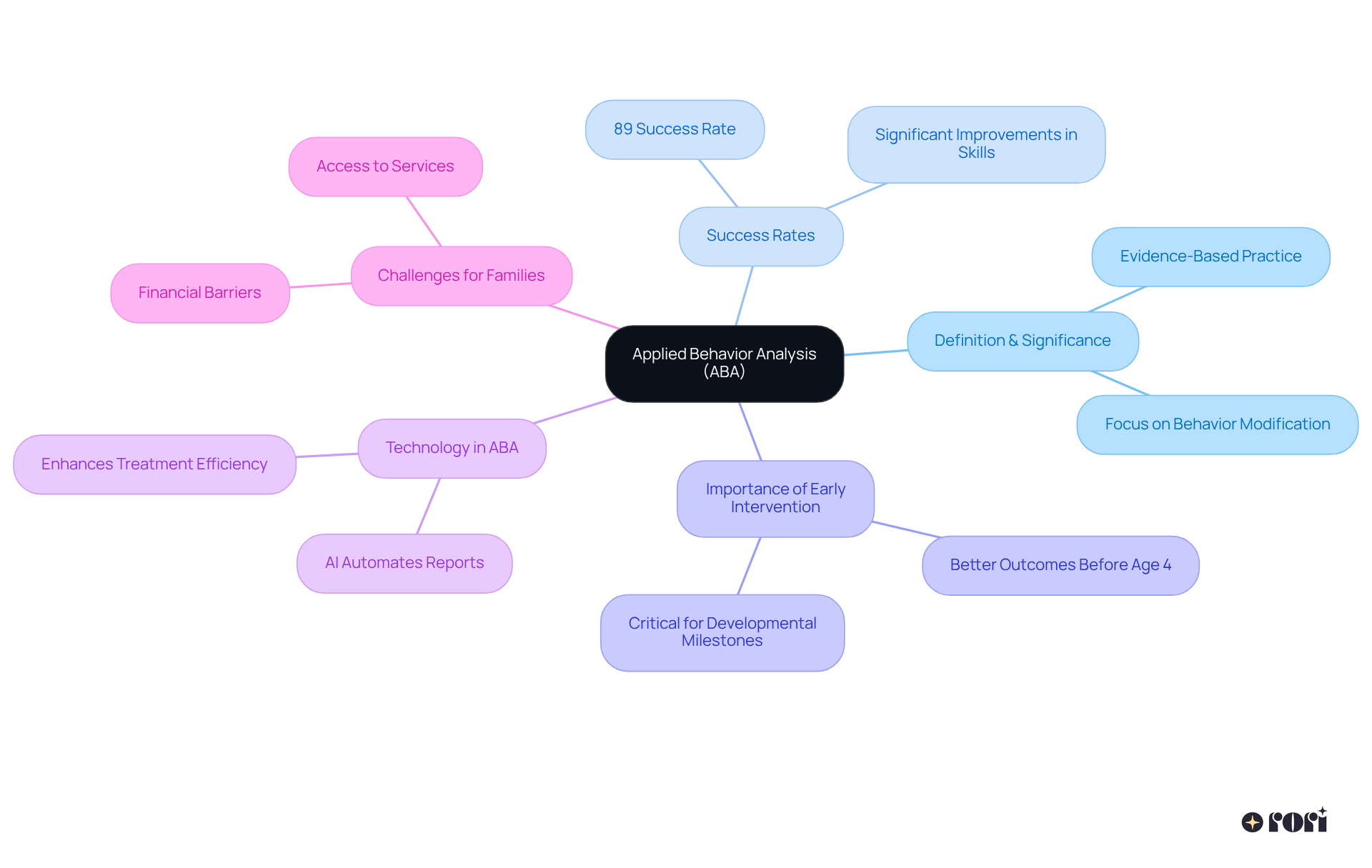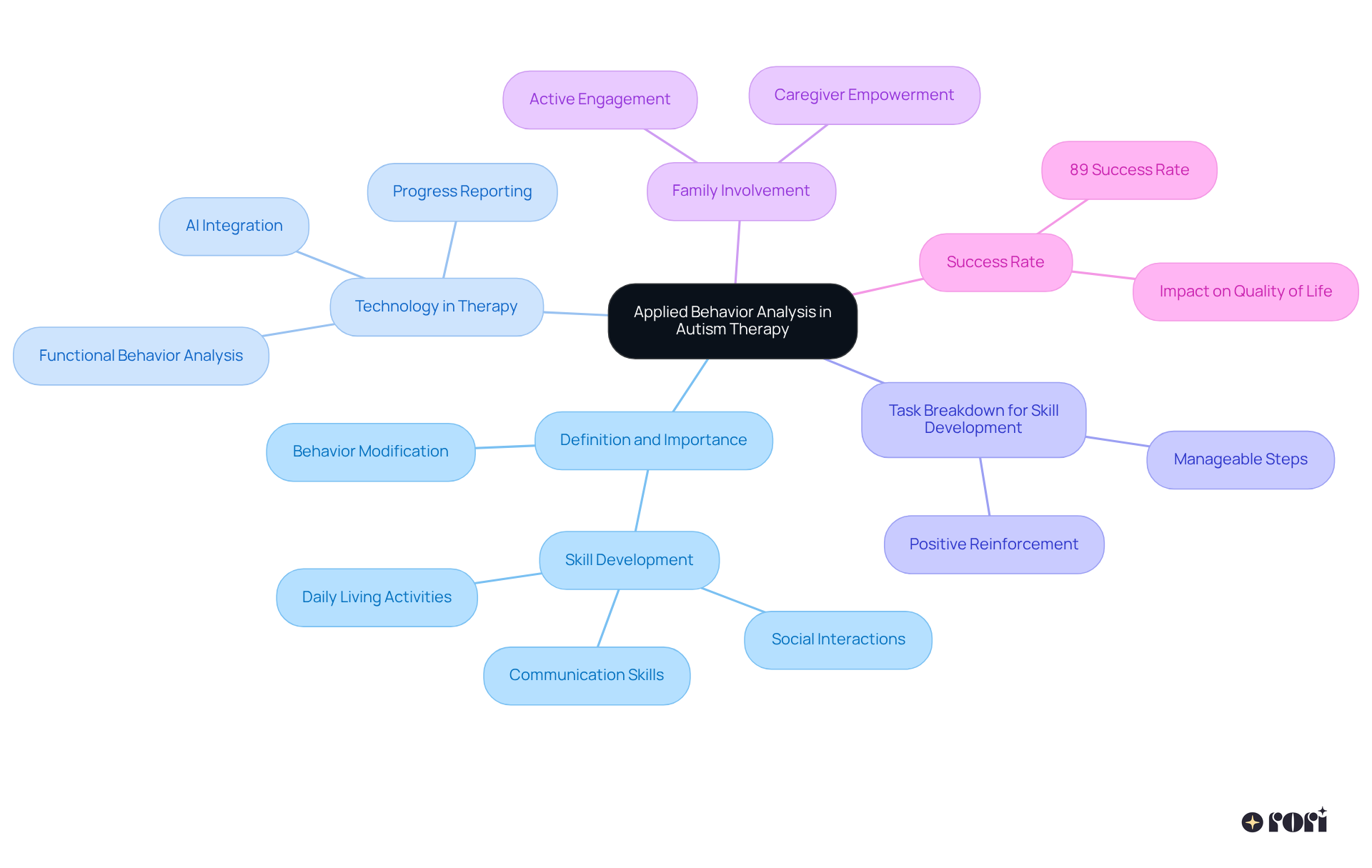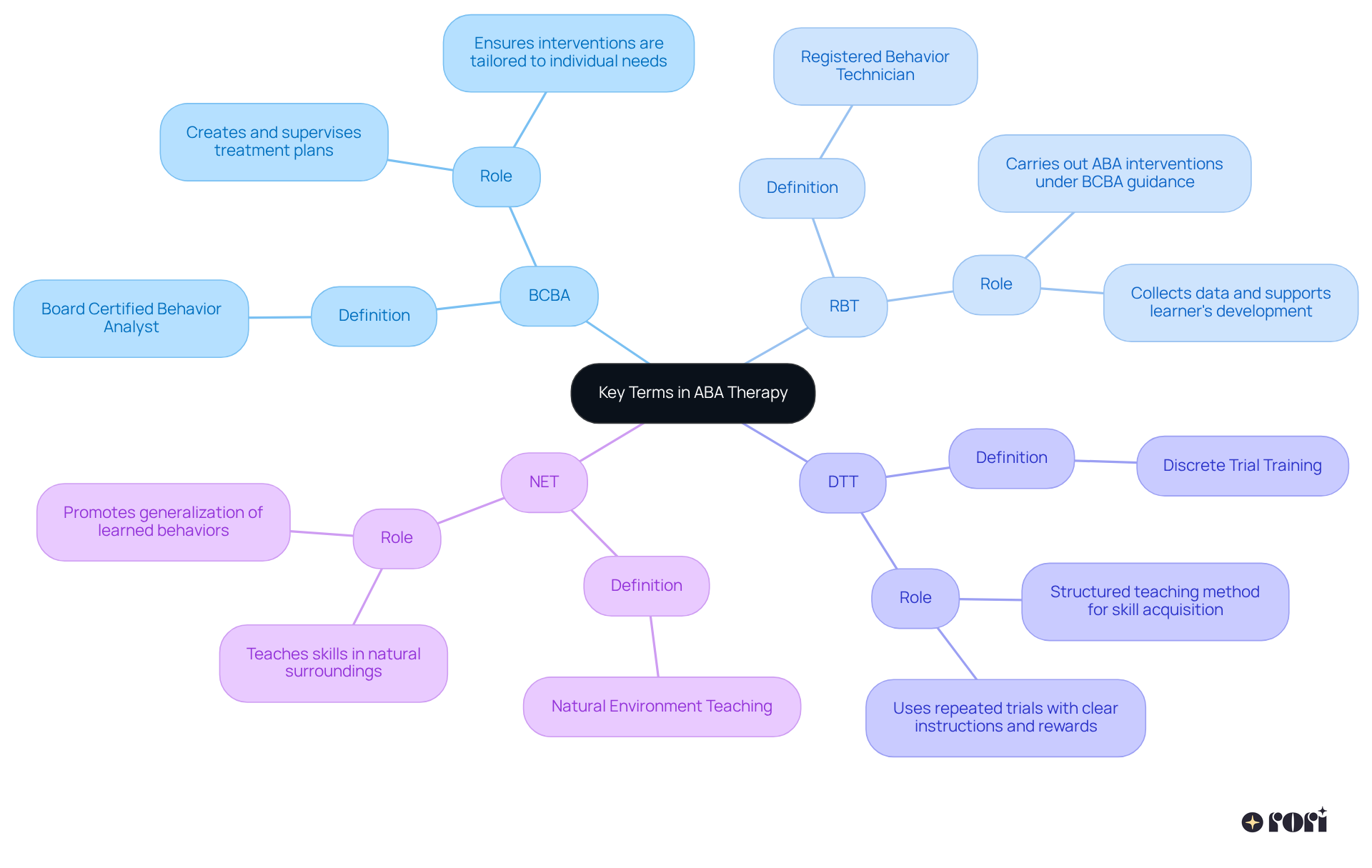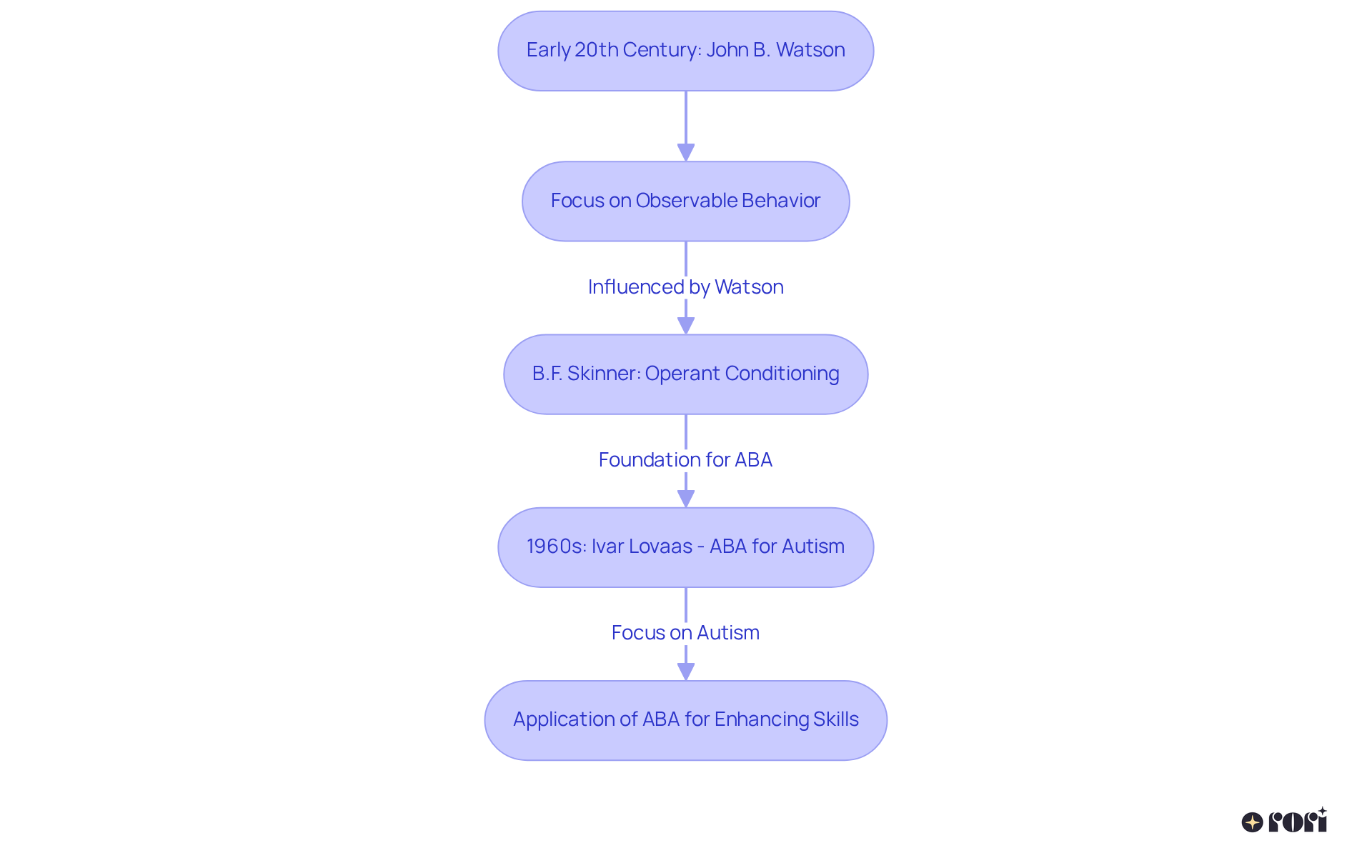This article highlights the importance of Applied Behavior Analysis (ABA) in therapy, especially for individuals with autism. It’s essential to understand some key terms and acronyms that come with this therapeutic approach. Did you know that ABA's structured interventions can significantly improve communication and social skills? In fact, it boasts a success rate of over 89%!
Moreover, this article emphasizes the value of early intervention and family involvement in the treatment process. As parents, navigating these challenges can feel overwhelming, but remember, you’re not alone. Let’s explore this together! We’re here to help you every step of the way!
Applied Behavior Analysis (ABA) is a leading approach in autism treatment, using evidence-based strategies to promote positive behavior changes. In this article, we’ll explore the essential acronyms and key terms that define ABA, shedding light on their importance for families navigating the complexities of autism therapy. As the need for these transformative interventions continues to grow, many families encounter barriers in accessing them. How can understanding these critical terms empower caregivers and enhance the therapeutic experience? Let’s dive in together!
Applied Behavior Analysis (ABA) is a fascinating field dedicated to understanding and enhancing our actions through thoughtful interventions. When it comes to autism treatment, ABA truly shines with its evidence-backed strategies that encourage positive behaviors while reducing challenging ones. Research reveals that ABA therapy boasts a success rate of over 89% in improving communication, social skills, and adaptive behaviors, especially for individuals with autism spectrum disorder (ASD).
By examining how behavior interacts with the environment, ABA practitioners can create personalized interventions tailored to each person's unique needs. This individualized approach not only boosts the quality of life for young people but also fosters greater independence. Isn’t it amazing? Children who begin ABA treatment before the age of two often experience even more significant improvements in social skills and language use, highlighting the critical importance of early intervention.
It's also important to note that half of the time spent in ABA sessions goes toward writing reports. But with the help of advanced AI technology, Rori Care - ABA Support is enhancing the effectiveness of ABA services by automating progress report creation. This innovation frees up to 50% more time for direct treatment! How great is that? It empowers caregivers with essential ABA principles and strategies, allowing them to actively support their loved ones' behavioral goals through informed decision-making and data collection.
Experts emphasize that the transformative impact of ABA treatment is vital for achieving meaningful progress in behavior and independence for children with ASD. However, many families face significant financial challenges when trying to access these essential services, highlighting the need for more support and resources. Let’s explore this together! We’re here to help you every step of the way!

Applied Behavior Analysis (ABA) is truly vital in autism treatment, offering a structured way to modify actions. Rooted in behaviorism, ABA operates on the belief that we can learn new behaviors or let go of unhelpful ones through reinforcement and outcomes. This approach is especially effective for teaching essential skills like communication, social interactions, and daily living activities.
At Rori Care - ABA Therapy, we embrace innovative AI technology to boost the effectiveness of our ABA therapy. Our behavior care engine conducts functional behavior analysis for target behaviors and skills, automatically generating progress reports for clinicians to review. This exciting advancement allows us to free up 50% more time for your dependent's treatment, so therapists can focus on delivering personalized care tailored to each individual’s unique needs.
By breaking down complex tasks into smaller, manageable steps and using positive reinforcement, therapists can significantly enhance individuals' abilities to develop crucial life skills. Recent studies highlight how effective ABA techniques can be, showing their positive impact on communication skills and overall functioning for individuals with autism.
Moreover, family involvement is key in the treatment journey. Our approach empowers caregivers with ABA principles and strategies, promoting active engagement and informed choices. As a result, ABA not only supports skill development but also helps young individuals navigate their environments more effectively, leading to a better quality of life.
With an impressive success rate of over 89% in addressing autism spectrum disorder in youth, ABA intervention showcases the transformative power of early action. It’s a vital part of autism care, and we’re here to help you every step of the way! Let’s explore this together!

In the world of ABA practices, you'll often come across an aba acronym list that represents essential roles and methods contributing to effective autism interventions. Understanding these concepts is super important for parents and caregivers as they navigate the complexities of autism treatment. This knowledge helps them engage with specialists and advocate for their child's needs.
BCBA: Board Certified Behavior Analyst. This professional has gone through rigorous education and experience to provide ABA services. BCBAs are responsible for creating and supervising treatment plans, ensuring that interventions are tailored to each individual's unique needs.
RBT: Registered Behavior Technician. An RBT is a paraprofessional who carries out ABA interventions under the guidance of a BCBA. RBTs play a vital role in delivering therapy, collecting data, and supporting the learner's development. To become an RBT, individuals must pass a board exam that assesses their skills in the RBT Task List, making sure they’re ready to help youth effectively.
DTT: Discrete Trial Training. This structured teaching method is used in ABA to teach skills systematically. For instance, a young learner might learn to identify colors through repeated trials, where each trial includes a clear instruction, a prompt, and a reward for correct answers.
NET: Natural Environment Teaching. This method focuses on teaching skills in the child’s natural surroundings, promoting the generalization of learned behaviors. For example, a young person might practice social skills during playtime with peers, helping them apply what they’ve learned in real-life situations.
Recent trends show a growing emphasis on blending DTT and NET within treatment sessions. Research indicates that combining structured and naturalistic approaches can improve learning outcomes. Plus, there’s a significant advancement noted in 90% of children when suggested hours are fully implemented with active caregiver participation. Importantly, ABA therapy is the only scientifically proven treatment for autism that is covered by insurance. By understanding the aba acronym list and their meanings, families can engage more effectively with the therapeutic process and support their child's development. Let’s explore this together!

Did you know that the roots of Applied Behavior Analysis (ABA) go way back to the early 20th century? It all started with pioneering behaviorists like John B. Watson and B.F. Skinner. Watson really focused on observable behavior, laying down the foundational principles of behaviorism. Then came Skinner, whose groundbreaking research on operant conditioning played a huge role in shaping ABA techniques.
Fast forward to the 1960s, and we see Ivar Lovaas stepping onto the scene as a key figure. He applied these behavioral principles specifically to children with autism, showing just how effective ABA could be in enhancing social and communication skills. At Rori Care, our clinical leadership team—made up of compassionate professionals—continues this important work. We apply ABA principles to empower caregivers and support children's developmental goals.
Over the years, ABA has evolved into a comprehensive and widely endorsed approach for treating autism. It's backed by a strong body of research and clinical evidence that highlights its effectiveness in fostering positive developmental outcomes. In fact, the American Psychological Association and other health authorities recognize ABA as an evidence-based practice, which speaks volumes about its rigorous foundation.
However, it's essential to have ongoing discussions about ABA, especially concerning traditional strategies and their impact on neurodiversity. This conversation emphasizes the need for a balanced view of this ever-evolving field. Remember, we’re here to help you every step of the way! Let’s explore this together!

Applied Behavior Analysis (ABA) is truly a cornerstone in autism therapy, providing a structured and evidence-based way to modify behaviors and improve the quality of life for individuals with autism spectrum disorder (ASD). With personalized interventions, ABA not only helps develop essential skills but also encourages independence, especially when started early in a child's journey.
In this article, we explore the significance of various key terms and acronyms related to ABA, like BCBA, RBT, DTT, and NET. These terms play vital roles in delivering effective therapy. We also highlight how family involvement and innovative technologies can enhance the therapeutic process, allowing for more focused and individualized care. Plus, the historical context of ABA shows its evolution and the solid research backing its effectiveness in achieving meaningful outcomes for children with autism.
Reflecting on these insights, it’s clear that understanding ABA and its terminology is essential for parents and caregivers navigating the complexities of autism treatment. As families advocate for their children's needs, having a deeper knowledge of ABA practices can empower them to engage more effectively with professionals. Embracing the transformative potential of ABA not only boosts individual capabilities but also builds a supportive community that champions the rights and development of those with autism.
Let’s explore this together! We’re here to help you every step of the way!
What is Applied Behavior Analysis (ABA)?
Applied Behavior Analysis (ABA) is a field focused on understanding and enhancing behaviors through targeted interventions, particularly effective in treating autism spectrum disorder (ASD) by promoting positive behaviors and reducing challenging ones.
What is the success rate of ABA therapy for individuals with autism?
Research indicates that ABA therapy has a success rate of over 89% in improving communication, social skills, and adaptive behaviors for individuals with autism spectrum disorder (ASD).
How does ABA therapy personalize interventions?
ABA practitioners examine how behavior interacts with the environment to create tailored interventions that meet each person's unique needs, enhancing their quality of life and fostering greater independence.
Why is early intervention important in ABA therapy?
Children who begin ABA treatment before the age of two often experience more significant improvements in social skills and language use, underscoring the critical importance of early intervention.
What percentage of time in ABA sessions is spent on writing reports?
Half of the time spent in ABA sessions is dedicated to writing reports.
How is Rori Care - ABA Support improving ABA services?
Rori Care - ABA Support enhances ABA services by using advanced AI technology to automate the creation of progress reports, freeing up to 50% more time for direct treatment.
How does Rori Care empower caregivers in ABA therapy?
Rori Care equips caregivers with essential ABA principles and strategies, enabling them to support their loved ones' behavioral goals through informed decision-making and data collection.
What challenges do families face in accessing ABA services?
Many families encounter significant financial challenges when trying to access essential ABA services, highlighting the need for increased support and resources.